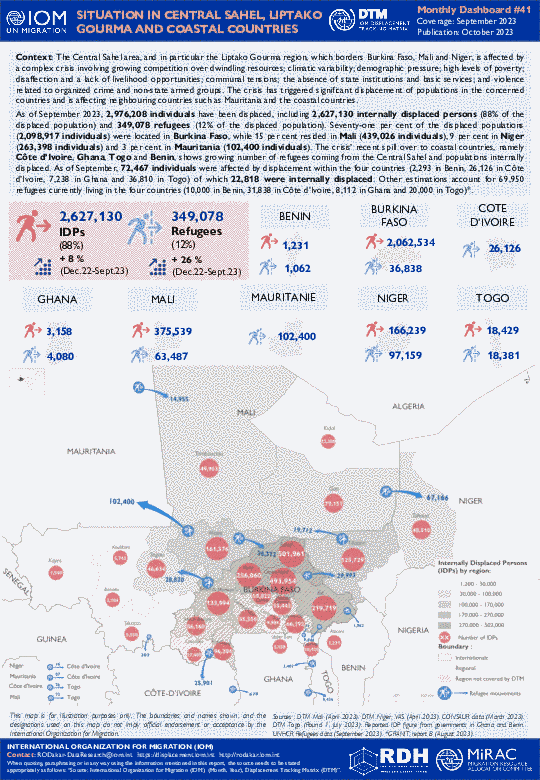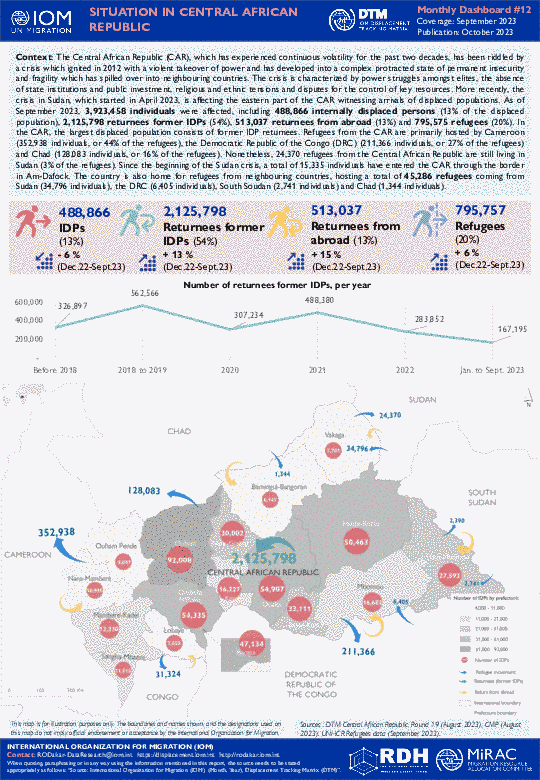-
Countries
-
Data and Analysis
-
Special Focus
-
Crisis Responses
Contact
DTMUkraine@iom.int
Location
Ukraine
Activity
- Survey
- Return Intention
Period Covered
May 01 2023 -Jun 30 2023
In round 3, out of the 156 return locations assessed, 25 recorded high severity conditions for one or more driver of severity. This equates to nearly a third of the estimated returnee population in assessed locations residing in high severity conditions (31%, 432,000 people).
This is a restricted dataset. To get access, kindly click on the 'Request Access' button.
Population Groups
Survey Methodology
Unit of Analysis Or Observation
Type of Survey or Assessment
Keywords
Geographical Scope
Administrative boundaries with available data
The current dataset covers the following administrative boundaries
Contact
DTMUkraine@iom.int
Location
Ukraine
Activity
- Survey
- Return Intention
Period Covered
Mar 01 2023 -Apr 30 2023
In round 2, out of the 117 return locations assessed, 23 recorded high severity conditions for one or more driver of severity. This equates to nearly a third of the estimated returnee population in assessed settlements residing in high severity conditions (29%, 499,000 people).
This is a restricted dataset. To get access, kindly click on the 'Request Access' button.
Population Groups
Survey Methodology
Unit of Analysis Or Observation
Type of Survey or Assessment
Keywords
Geographical Scope
Administrative boundaries with available data
The current dataset covers the following administrative boundaries
Contact
DTMUkraine@iom.int
Location
Ukraine
Activity
- Survey
- Return Intention
Period Covered
Jul 01 2023 -Aug 31 2023
In round 4 assessment, nearly a third of the estimated returnee population reside in locations which recorded high severity for one or more drivers of severity. This equates to approximately 680,000 people residing in high severity conditions in 57 locations, amidst 186 return locations assessed.
This is a restricted dataset. To get access, kindly click on the 'Request Access' button.
Population Groups
Survey Methodology
Unit of Analysis Or Observation
Type of Survey or Assessment
Keywords
Geographical Scope
Administrative boundaries with available data
The current dataset covers the following administrative boundaries
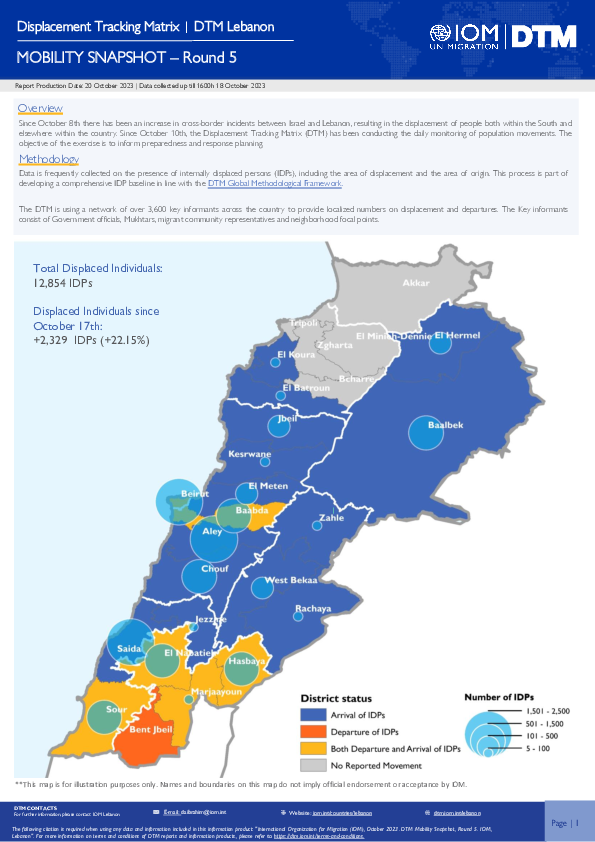
Contact
daibrahim@iom.int
Language
English
Location
Lebanon
Period Covered
Oct 10 2023
Oct 18 2023
Activity
- Mobility Tracking
- Baseline Assessment
Since October 8 there has been an increase in cross-border incidents between Israel and Lebanon, resulting in the displacement of people both within the South and elsewhere within the country. Since October 10, the Displacement Tracking Matrix (DTM) has been conducting the daily monitoring of population movements. The objective of the exercise is to inform preparedness and response planning.
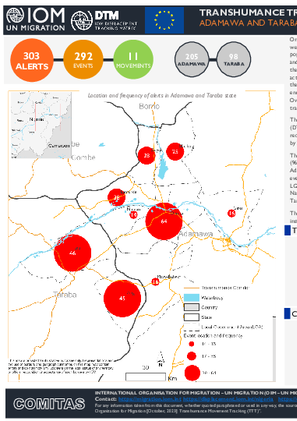
Contact
DTM Nigeria, AllUsersInDTMNigeria@iom.int
Language
English
Location
Nigeria
Period Covered
Sep 01 2023
Sep 30 2023
Activity
- Survey
In northern Nigeria and other Sahel regions, the escalation of hostility and violent conflicts between transhumant herders and farmers are linked to several key factors. One of the main contributors is the competition over natural resources, which is exacerbated by the low rainfall, insecurity, insurgency, growing population and the attendant land-intensive demands for both farming and transhumance activities. Additionally, year-round farming and the conventional methods of land allocation to farming and herding activities add to the tensions, as farmers may encroach on designated grazing areas and routes, and herders in turn resort to destructive practices such as trespassing on farmlands, causing crop destruction and polluting water sources to feed their cattle. These factors sometimes result in deadly conflicts.
The Transhumance Tracking Tool (TTT) within the framework of IOM's Displacement Tracking Matrix (DTM) utilizes information provided by community Key Informants through a designated focal person to record alerts related to transhumance activities. This report showcases the early warning alerts collected by TTT in 9 Local Government Areas (LGAs) across Adamawa and Taraba states for September 2023.
The triangulated 303 alerts linked to transhumance related events for September 2023 comprises of 292 (96%) events and 11 (4%) movement alerts. The largest number of alerts were reported in Demsa LGA in Adamawa state (22%), followed by Zing LGAs (17%) and Lau (16%) in Taraba state. The disaggregated event alerts in the two states reveal that the highest reported events occurred in Monkin ward of Zing LGA in Taraba state, accounting for 6.5 per cent of the total. This was followed by Gwamba and Nassarawo Demsa wards in Demsa LGA of Adamawa, at 4.8 per cent each, and Zing ward in Zing LGA of Taraba state, which reported 4.1 per cent of the total event alerts.
The reported alerts suggested the instance of 1 per cent population displacement, while 15 per cent of the instances resulted in casualties or injuries.
The Central Sahel area, and in particular the Liptako Gourma region, which borders Burkina Faso, Mali and Niger, is affected by a complex crisis involving growing competition over dwindling resources; climatic variability; demographic pressure; high levels of poverty; disaffection and a lack of livelihood opportunities; communal tensions; the absence of state institutions and basic services; and violence related to organized crime and non-state armed groups. The crisis has triggered significant displacement of populations in the concerned countries and is affecting neighbouring countries such as Mauritania and the coastal countries.
As of September 2023, 2,976,208 individuals have been displaced, including 2,627,130 internally displaced persons (88% of the displaced population) and 349,078 refugees (12% of the displaced population). Seventy-one per cent of the displaced populations (2,098,917 individuals) were located in Burkina Faso, while 15 per cent resided in Mali (439,026 individuals), 9 per cent in Niger (263,398 individuals) and 3 per cent in Mauritania (102,400 individuals). The crisis’ recent spill over to coastal countries, namely Côte d’Ivoire, Ghana, Togo and Benin, shows growing number of refugees coming from the Central Sahel and populations internally displaced. As of September, 72,467 individuals were affected by displacement within the four countries (2,293 in Benin, 26,126 in Côte d’Ivoire, 7,238 in Ghana and 36,810 in Togo) of which 22,818 were internally displaced. Other estimations account for 69,950 refugees currently living in the four countries (10,000 in Benin, 31,838 in Côte d’Ivoire, 8,112 in Ghana and 20,000 in Togo)*.
The crisis currently affecting the Lake Chad Basin states results from a complex combination of factors, including conflict with non-state armed groups, extreme poverty, underdevelopment and a changing climate, which together have triggered significant displacement of populations. As of September 2023, Cameroon, Chad, Niger and Nigeria were hosting an estimated 5,949,994 affected individuals made up of internally displaced persons (IDPs), returnees (former IDPs and returnees from abroad) and refugees (both in- and out-of-camp).
The Central African Republic (CAR), which has experienced continuous volatility for the past two decades, has been riddled by a crisis which ignited in 2012 with a violent takeover of power and has developed into a complex protracted state of permanent insecurity and fragility which has spilled over into neighbouring countries. The crisis is characterized by power struggles amongst elites, the absence of state institutions and public investment, religious and ethnic tensions and disputes for the control of key resources. More recently, the crisis in Sudan, which started in April 2023, is affecting the eastern part of the CAR witnessing arrivals of displaced populations. As of September 2023, 3,923,458 individuals were affected, including 488,866 internally displaced persons (13% of the displaced population), 2,125,798 returnees former IDPs (54%), 513,037 returnees from abroad (13%) and 795,575 refugees (20%). In the CAR, the largest displaced population consists of former IDP returnees. Refugees from the CAR are primarily hosted by Cameroon (352,938 individuals, or 44% of the refugees), the Democratic Republic of the Congo (DRC) (211,366 individuals, or 27% of the refugees) and Chad (128,083 individuals, or 16% of the refugees). Nonetheless, 24,370 refugees from the Central African Republic are still living in Sudan (3% of the refugees). Since the beginning of the Sudan crisis, a total of 15,335 individuals have entered the CAR through the border in Am-Dafock. The country is also home for refugees from neighbouring countries, hosting a total of 45,286 refugees coming from Sudan (34,796 individuals), the DRC (6,405 individuals), South Soudan (2,741 individuals) and Chad (1,344 individuals).
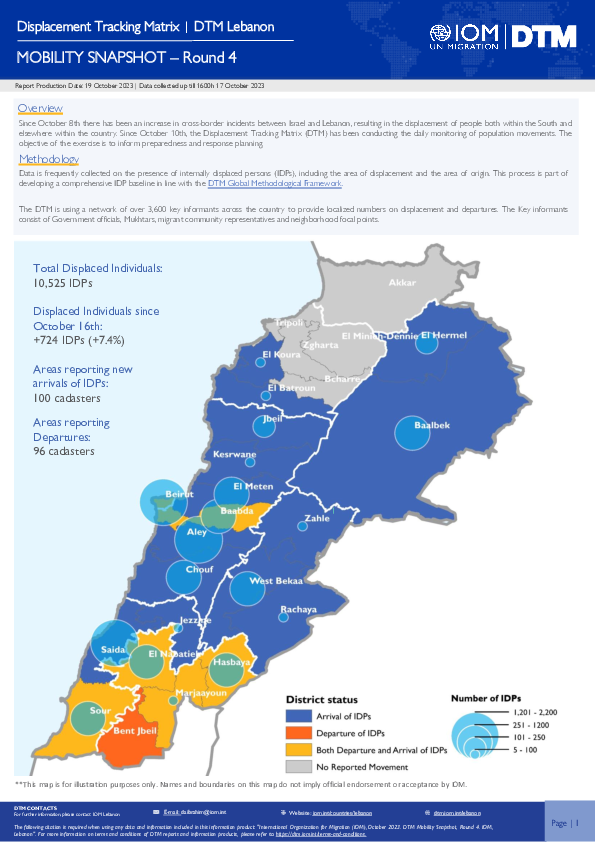
Contact
daibrahim@iom.int
Language
English
Location
Lebanon
Period Covered
Oct 10 2023
Oct 17 2023
Activity
- Mobility Tracking
- Baseline Assessment
Since October 8 there has been an increase in cross-border incidents between Israel and Lebanon, resulting in the displacement of people both within the South and elsewhere within the country. Since October 10, the Displacement Tracking Matrix (DTM) has been conducting the daily monitoring of population movements. The objective of the exercise is to inform preparedness and response planning.
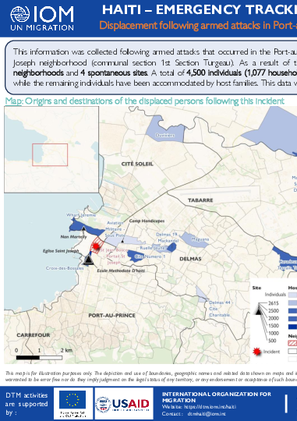
Contact
dtmhaiti@iom.int
Language
English
Location
Haiti
Period Covered
Oct 13 2023
Oct 17 2023
Activity
- Mobility Tracking
- Event Tracking
This information was collected following armed attacks that occurred in the Port-au-Prince municipality since 13 October 2023, specifically in the St Jean Bosco - Portail St Joseph neighborhood (communal section 1st Section Turgeau). As a result of these attacks, residents from this neighborhood were forced to flee to 12 different neighborhoods and 4 spontaneous sites. A total of 4,500 individuals (1,077 households) have been displaced. Among them, 3,594 persons (80%) have sought refuge in sites, while the remaining individuals have been accommodated by host families. This data was collected from key informants through telephone interviews.
